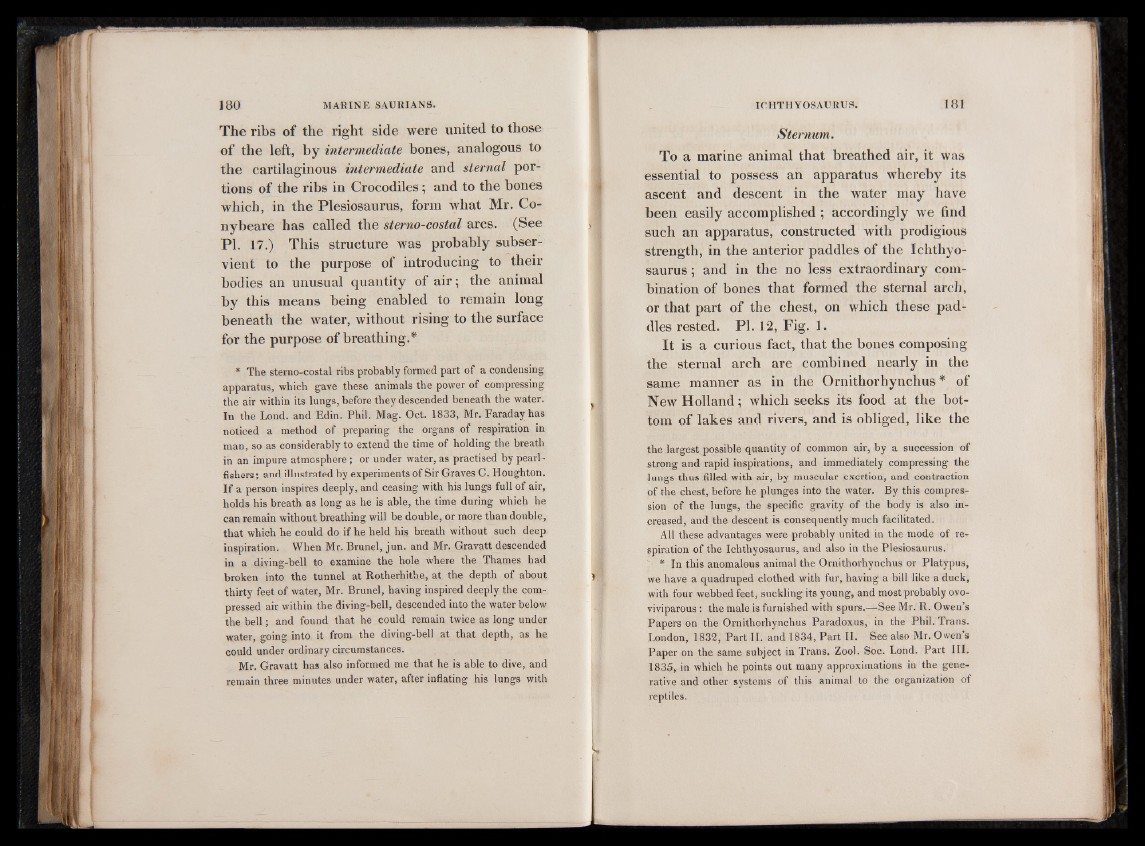
The ribs of the right side were united to those
of the left, by intermediate bones, analogous to
the cartilaginous intermediate and sternal portions
of the ribs in Crocodiles; and to the bones
which, in the Plesiosaurus, form what Mr. Co-
nybeare has called the sterno-costal arcs. (See
PI. 17.) This structure was probably subservient
to the purpose of introducing to their
bodies an unusual quantity of air; the animal
by this means being enabled to remain long
beneath the water, without rising to the surface
for the purpose of breathing.*
* The sterno-costal ribs probably formed part of a condensing
apparatus, which gave these animals the power of compressing
the air within its lungs, before they descended beneath the water.
In the Lond. and Edin. Phil. Mag. Oct. 1833, Mr. Faraday has
noticed a method of preparing the organs of respiration in
man, so as considerably to extend the time of holding the breath
in an impure atmosphere; or under water, as practised by pearl-
fishers; and illustrated by experiments of Sir Graves C. Houghton.
If a person inspires deeply, and ceasing with his lungs full of air,
holds his breath as long as he is able, the time during which he
can remain without breathing will be double, or more than double,
that which he could do if he held his breath without such deep
inspiration. When Mr. Brunei, jun. and Mr. Gravatt descended
in a diving-bell to examine the hole where the Thames had
broken into the tunnel at Rotherhithe, at the depth of about
thirty feet of water, Mr. Brunei, having inspired deeply the compressed
air within the diving-bell, descended into the water below
the b e ll; and found that he could remain twice as long under
water, going into it from the diving-bell at that depth, as he
could under ordinary circumstances.
Mr. Gravatt has also informed me that he is able to dive, and
remain three minutes under water, after inflating his lungs with
Sternum.
To a marine animal that breathed air, it was
essential to possess an apparatus whereby its
ascent and descent in the water may have
been easily accomplished ; accordingly we find
such an apparatus, constructed with prodigious
strength, in the anterior paddles of the Ichthyosaurus;
and in the no less extraordinary combination
of bones that formed the sternal arch,
or that part of the chest, on which these paddles
rested. PI. 12, Fig. 1.
It is a curious fact, that the bones composing
the sternal arch are combined nearly in the
same manner as in the Ornithorhynchus * of
New Holland; which seeks its food at the bottom
of lakes and rivers, and is obliged, like the
the largest possible quantity of common air, by a succession of
strong and rapid inspirations, and immediately compressing the
lungs thus filled with air, by muscular exertion, and contraction
of the chest, before he plunges into the water. By this compression
of the lungs, the specific gravity of the body is also increased,
and the descent is consequently much facilitated.
All these advantages were probably united in the mode of respiration
of the Ichthyosaurus, and also in the Plesiosaurus.
* In this anomalous animal the Ornithorhynchus or Platypus,
we have a quadruped clothed with fur, having a bill like a duck,
with four webbed feet, suckling its young, and most probably ovo-
viviparous; the male is furnished with spurs.—See Mr. R. Owen’s
Papers on the Ornithorhynchus Paradoxus, in the Phil. Trans.
London, 1832, Part II. and 1834, Part II. See also Mr. Owen s
Paper on the same subject in Trans. Zool. Soc. Lond. Part III.
1835, in which he points out many approximations in the generative
and other systems of this animal to the organization of
reptiles.